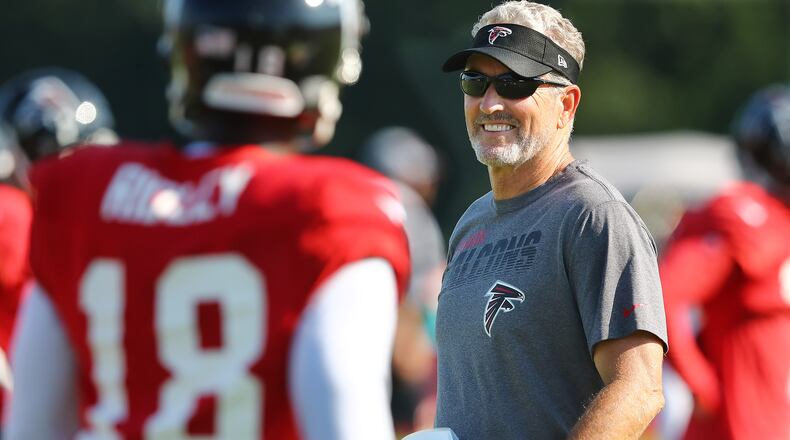Former Falcons offensive coordinator Steve Sarkisian was on the wrong side of an NFL trend in 2017. The evidence shows that it's more efficient to throw the ball using play-action passes than with straight drop backs, independent of how well a team runs the ball. The Falcons had used play-action (faking a run hand-off before passing) more often than any team in 2016 with fantastic success. But Sarkisian drastically reduced those plays in 2017 even though his unit ranked sixth in efficiency when using them.
To his credit, Sarkisian got on the right side of the trend last season. The Falcons ranked ninth in play-action usage and eighth in efficiency. Maybe it would have worked out better if he had a functional offensive line. Now we’ll see if Sarkisian’s successor, Dirk Koetter, will stick with the same plan (though the O-line still has issues).
Koetter hasn’t used a lot of play-action as an NFL coach. Obviously, it’s too soon to tell how much they’ll be part of his game plans in his second go-around as Falcons coordinator. But if the Week 1 loss at Minnesota is any indication, Koetter will call play-action passes more frequently than what’s normal for him.
By my count, the Falcons used play-action on six of 21 pass attempts (29 percent) against the Vikings (not including scrambles, two-minute offense and garbage time). That’s a high rate. Koetter had Ryan in shotgun on 15 of those 21 pass attempts, probably because of concerns about Minnesota’s pass rush. The Falcons still ran play-action on three of those dropbacks.
The verdict is mixed on whether play-action was effective against the Vikings.
Ryan completed 6 of 9 play-action pass attempts against the Vikings for 49 yards with two interceptions and one sack. With no play action Ryan completed eight of 13 attempts for 58 yards with two sacks, plus a 26-yard pass interference penalty. The Falcons had a 44 success rate on their nine play-action pass attempts and a 38 percent success rate on their 13 attempts without it.
The Falcons were moving the ball well with play-action passes on the drive that ended with Devonta Freeman’s fumble. But they also had success throwing it without play-action on the drive that ended with Ryan’s interception, which happened on a play-action bootleg.
The frequency of play-action passes has gone through phases in the NFL, according to Football Outsiders data. After usage was flat from 2008 to 2011 it increased significantly from 2012 to 2014 as several teams incorporated read-option plays into their rule book. It decreased in 2015 and 2016 as the read-option fell out of favor. The past two seasons play-action passes increased to even higher levels than from 2012-14.
Teams have used more run-pass options over the past two seasons. But, as Bryan Knowles wrote at Football Outsiders, RPOs don't explain why play-action passes have become more effective: "Play-action passing makes passing easier. Defenders have to respect the possibility of the run, and so hesitate in their pass rush and their coverage." This effect doesn't appear to have diminishing returns during a game.
Koetter hasn’t been part of the play-action trend. From 2012 to 2018 teams with Koetter as coordinator or head coach ranked higher than 16th in play-action frequency just once. That was in 2016, when Koetter succeeded Mike Smith as Buccaneers head coach and hired Todd Monken as OC.
Dirk Koetter and play-action passes
*Defense-Adjusted Value Over Average
+Offensive coordinator Todd Monken
The Bucs had been very efficient on play-action passes in 2015 with Koetter as OC and rookie QB Jameis Winston but used them at a rate below the league average. In 2016 the Bucs had the sixth-highest frequency and second-highest efficiency on play-action. In Koetter’s next two years as head coach the Bucs went back to using relatively few play-action passes.
But the 2017 and 2018 Bucs also drastically increased their efficiency when passing without play-action. The same was true for the Falcons when Koetter was their OC from 2012-14. During those five seasons Koetter showed that he can dial up an efficient passing offense without using much play-action.
However, the most efficient offense among those teams was the 2014 Falcons, who ranked 10th by Football Outsiders in Defensive-Adjusted Value Over Average. And now Koetter is reunited with Ryan, whose career-best season came with Kyle Shanahan running a lot of play-action. With Ryan’s history and the NFL trends both pointing to the effectiveness of play-action, I’m interested to see if Koetter also goes in that direction.
About the Author
The Latest
Featured


